It looks like you're using an Ad Blocker.
Please white-list or disable AboveTopSecret.com in your ad-blocking tool.
Thank you.
Some features of ATS will be disabled while you continue to use an ad-blocker.
share:
Robert Temple draws attention to a number of curious features set within the Temples of the Giza plateau in his video here
The true location of the Royal Tombs at Giza, which as the title suggests has caused him to
consider that they relate to the true burial sites of the Pharoahs, which i don't agree with but the features he draws attention to are intriguing,
which are a number of sealed channels which he considers to have been cable conduits for lowering of coffins.
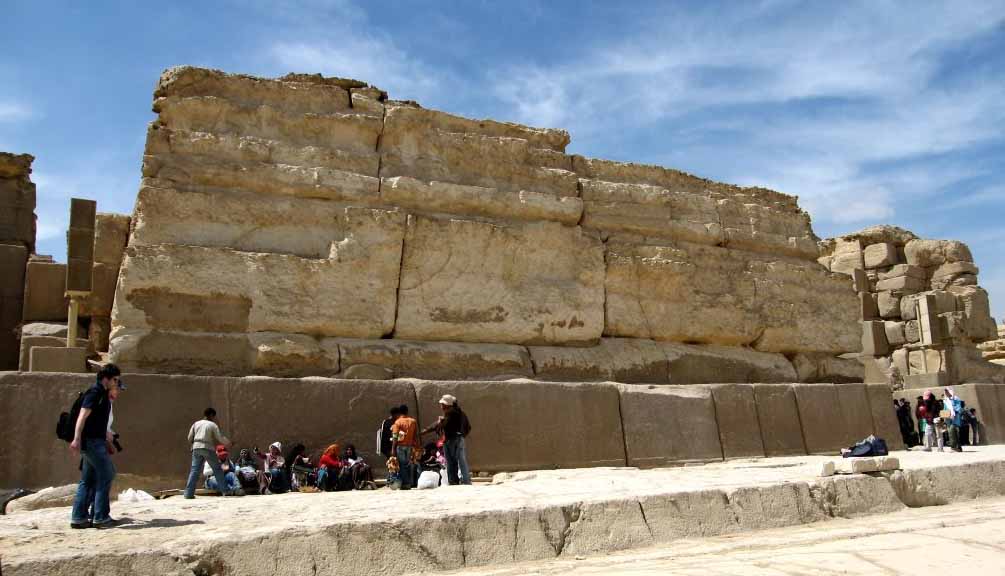
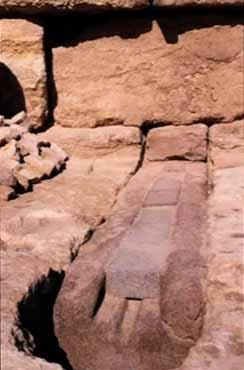 The first one that caught his attention is set at the base of the North wall of
the Sphinx Temple, set into a slab of pink granite which he estimates to be around 30 feet in length and weigh around 100 tons, a groove is set into
this and tightly packed granite blocks above it create the sealed channel, this runs beneath the North wall before shortly ending beneath a cliff
face.
The first one that caught his attention is set at the base of the North wall of
the Sphinx Temple, set into a slab of pink granite which he estimates to be around 30 feet in length and weigh around 100 tons, a groove is set into
this and tightly packed granite blocks above it create the sealed channel, this runs beneath the North wall before shortly ending beneath a cliff
face.
This and the other similar features have puzzled archaeologists when first excavated but they simply decided they were drainage channels, Temple disagrees with this as do i, because the incline of the channel in the North wall of the sphinx temple is inward, and also as drainage channels apart from having little carrying capacity they would be very easily blocked, a shallow open channel set into the paving would always suffice better than these elaborate features.
A similar example is found at the valley Temple of Khafre next to the Sphinx temple again this is an elaborate construction with very little carrying capacity if intended for drainage, it enters and exits beneath the Western wall.
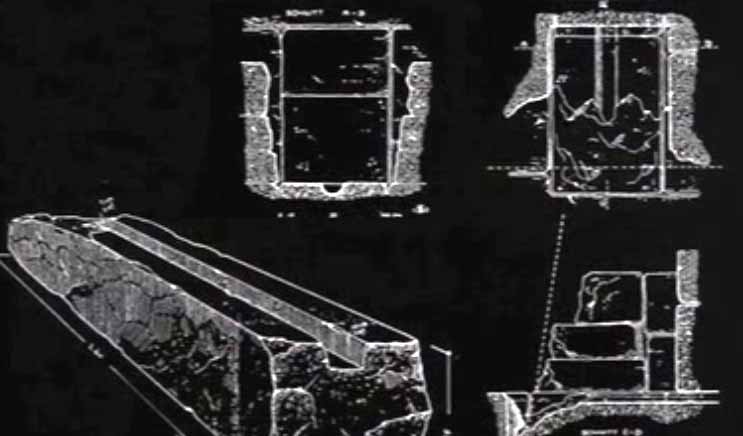
Were Temples theory fails with regards to these having been used to lower the body of Pharoahs beneath the floor is that an example is also seen at the Funerary temple of Khafre, so he could hardly be buried beneath his funerary and valley temples...
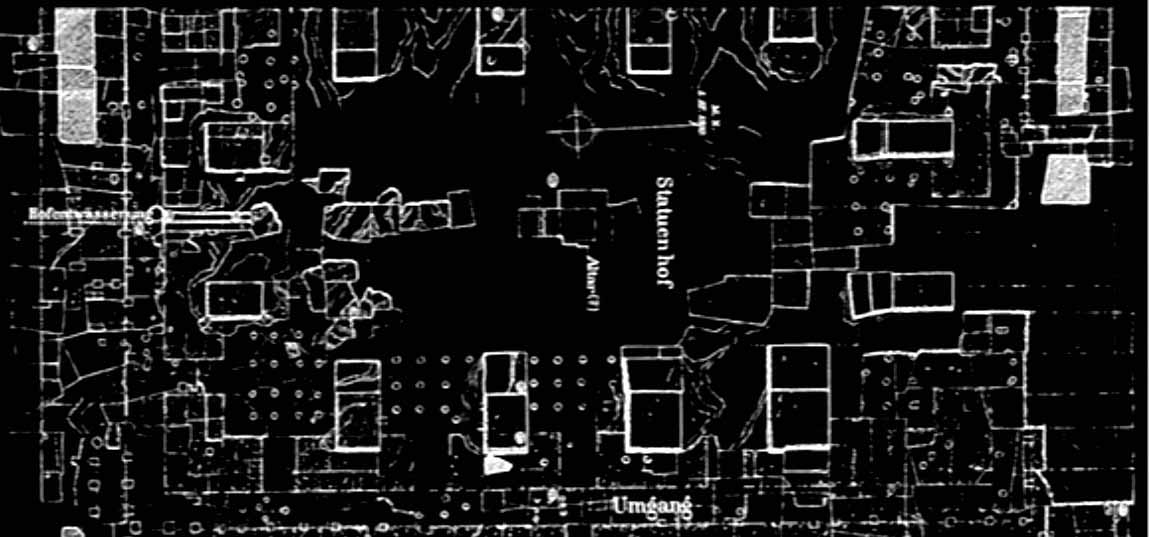
What Robert Temple does however rather unwittingly is prove that the sphinx Temple dates to the other buildings of the Gize plateau by having shared architectural features, seen below is the channel of the Khafre funerary Temple.
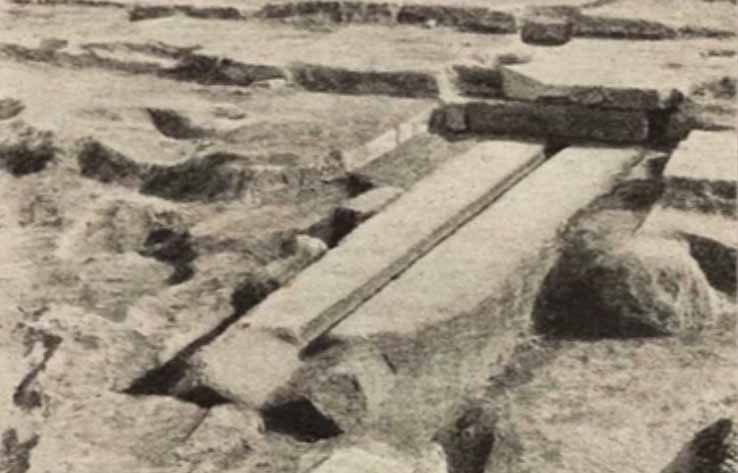
The funerary temple of Khufu beneath the Great Pyramid also had such a channel set within it's basalt flooring;
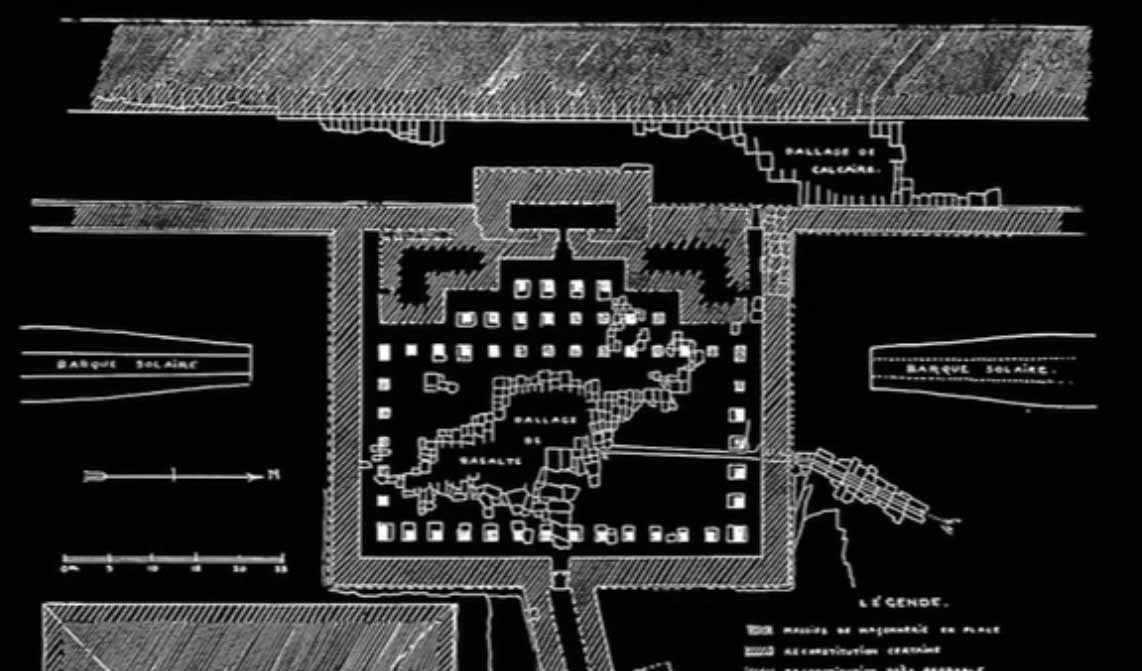
So it becomes apparent that whether entirely practical features or related to ritual these channels were important considerations in the architecture of the temple complexes of the Giza plateau, which can also be seen in the valley temple of Menkaure;
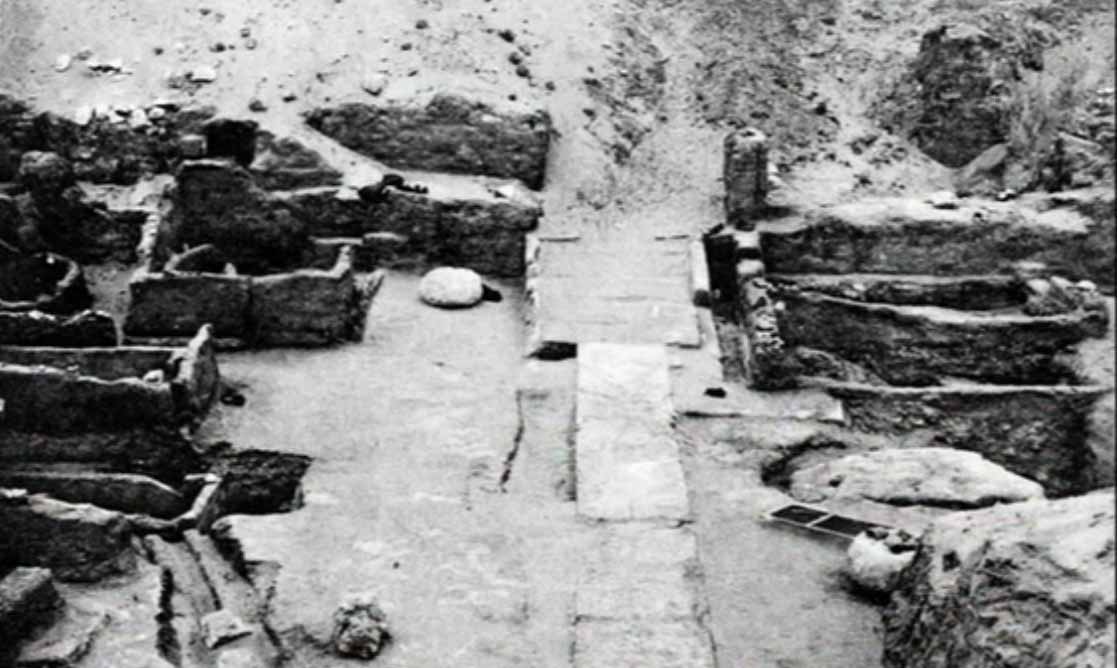
There it can be seen as perhaps having some relationship to the stone chamber set into the ground seen to the left, and also seen in this image;

In the site plan it can be seen to be quite centrally located, appears to run towards the stone chamber in one direction and exit beneath a wall in the other, all very curious.
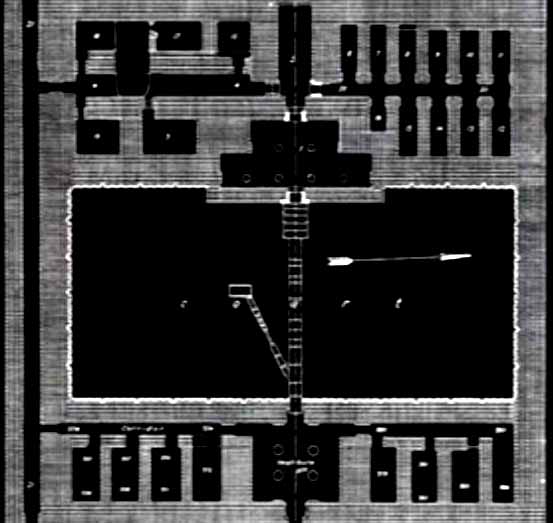
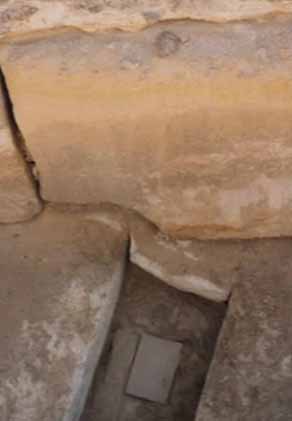 It's difficult then in my opinion to understand what these features related to,
Robert Temples considerations i think mistaken, if you were going to use them to run lowering cables through i would consider you'd need two set
facing each other, but also they couldn't have carried rope of any great thickness, and in the example set into the North wall of the sphinx temple
there isn't any space between were the conduit ends at the cliff face, there is simply nowhere for people at the end to stand and pull
It's difficult then in my opinion to understand what these features related to,
Robert Temples considerations i think mistaken, if you were going to use them to run lowering cables through i would consider you'd need two set
facing each other, but also they couldn't have carried rope of any great thickness, and in the example set into the North wall of the sphinx temple
there isn't any space between were the conduit ends at the cliff face, there is simply nowhere for people at the end to stand and pull
As drainage channels for reasons stated they seem hopeless, but clearly whatever was intended to be run though them was heavily protected and sealed, if you were wanting to run electrical cable through them they'd have been ideal for that, so something of a mystery in my opinion, and i'd be open to suggestions on these...maybe something sensible.

 The first one that caught his attention is set at the base of the North wall of
the Sphinx Temple, set into a slab of pink granite which he estimates to be around 30 feet in length and weigh around 100 tons, a groove is set into
this and tightly packed granite blocks above it create the sealed channel, this runs beneath the North wall before shortly ending beneath a cliff
face.
The first one that caught his attention is set at the base of the North wall of
the Sphinx Temple, set into a slab of pink granite which he estimates to be around 30 feet in length and weigh around 100 tons, a groove is set into
this and tightly packed granite blocks above it create the sealed channel, this runs beneath the North wall before shortly ending beneath a cliff
face. This and the other similar features have puzzled archaeologists when first excavated but they simply decided they were drainage channels, Temple disagrees with this as do i, because the incline of the channel in the North wall of the sphinx temple is inward, and also as drainage channels apart from having little carrying capacity they would be very easily blocked, a shallow open channel set into the paving would always suffice better than these elaborate features.
A similar example is found at the valley Temple of Khafre next to the Sphinx temple again this is an elaborate construction with very little carrying capacity if intended for drainage, it enters and exits beneath the Western wall.

Were Temples theory fails with regards to these having been used to lower the body of Pharoahs beneath the floor is that an example is also seen at the Funerary temple of Khafre, so he could hardly be buried beneath his funerary and valley temples...

What Robert Temple does however rather unwittingly is prove that the sphinx Temple dates to the other buildings of the Gize plateau by having shared architectural features, seen below is the channel of the Khafre funerary Temple.

The funerary temple of Khufu beneath the Great Pyramid also had such a channel set within it's basalt flooring;

So it becomes apparent that whether entirely practical features or related to ritual these channels were important considerations in the architecture of the temple complexes of the Giza plateau, which can also be seen in the valley temple of Menkaure;

There it can be seen as perhaps having some relationship to the stone chamber set into the ground seen to the left, and also seen in this image;

In the site plan it can be seen to be quite centrally located, appears to run towards the stone chamber in one direction and exit beneath a wall in the other, all very curious.

 It's difficult then in my opinion to understand what these features related to,
Robert Temples considerations i think mistaken, if you were going to use them to run lowering cables through i would consider you'd need two set
facing each other, but also they couldn't have carried rope of any great thickness, and in the example set into the North wall of the sphinx temple
there isn't any space between were the conduit ends at the cliff face, there is simply nowhere for people at the end to stand and pull
It's difficult then in my opinion to understand what these features related to,
Robert Temples considerations i think mistaken, if you were going to use them to run lowering cables through i would consider you'd need two set
facing each other, but also they couldn't have carried rope of any great thickness, and in the example set into the North wall of the sphinx temple
there isn't any space between were the conduit ends at the cliff face, there is simply nowhere for people at the end to stand and pull As drainage channels for reasons stated they seem hopeless, but clearly whatever was intended to be run though them was heavily protected and sealed, if you were wanting to run electrical cable through them they'd have been ideal for that, so something of a mystery in my opinion, and i'd be open to suggestions on these...maybe something sensible.
a reply to: Kantzveldt
If you would…
Do the channels always slope? Away or towards the coffin or chamber?
If you would…
Do the channels always slope? Away or towards the coffin or chamber?
a reply to: intrptr
I don't know, Robert Temple reckoned the sphinx temple conduit was sloping inwards, but the others evidenced from site plans and photos from the 1930's there's no information on, for example the valley temple of Menkaure is currently covered over with sand so that can't be determined.
As drainage channels they seem ridiculous given the tiny sealed channel created, once blocked they would have been incredibly difficult to unblock being set beneath the floor and also the thick walls.
I don't know, Robert Temple reckoned the sphinx temple conduit was sloping inwards, but the others evidenced from site plans and photos from the 1930's there's no information on, for example the valley temple of Menkaure is currently covered over with sand so that can't be determined.
As drainage channels they seem ridiculous given the tiny sealed channel created, once blocked they would have been incredibly difficult to unblock being set beneath the floor and also the thick walls.
a reply to: Kantzveldt
Dunno, got me then. It does't rain very often there, either. They appear really strong, too. Only thing I come up with is as an aid to construction, mounting rail for a crane structure to hoist stones, maybe?
The other creepy, nonsensical is blood channel for ritual sacrifice to keep the sun moving in the sky or something…
lulz
Dunno, got me then. It does't rain very often there, either. They appear really strong, too. Only thing I come up with is as an aid to construction, mounting rail for a crane structure to hoist stones, maybe?
The other creepy, nonsensical is blood channel for ritual sacrifice to keep the sun moving in the sky or something…
lulz
Suggesting that shared architectural features can date a structure is simply silly IMHO.
My house has roof tiles. They are nearly identical to roof tiles used by the roman empire.
The roman empire existed two thousand years ago. My house dates from the 1980s.
P
My house has roof tiles. They are nearly identical to roof tiles used by the roman empire.
The roman empire existed two thousand years ago. My house dates from the 1980s.
P
With everything we understand today about conductivity and the use of it today ourselves in watches as an easy example makes you really wonder what
the ancients knew, especially given the location of many of these sites.
Interesting read on the electrical properties of limestone and pink granite:
dergiler.ankara.edu.tr...
Maybe channeling water through it created the source they needed.
Interesting read on the electrical properties of limestone and pink granite:
dergiler.ankara.edu.tr...
Maybe channeling water through it created the source they needed.
a reply to: intrptr
Yes i don't think they could have been used for hauling because some of them turn at an angle which wouldn't have been helpful at all, some ritual aspect is a maybe, they were obviously considered important if constructed in granite.
a reply to: pheonix358
I mentioned that in the context of some considering the sphinx temple to be thousands of years older than the other funerary and valley temples, having such a shared peculiar architectural feature does suggest they were of the same period because whilst drainage channels are common enough one's that don't appear to make practical sense aren't.
a reply to: Rosinitiate
They did have strange interest in granite, at the sphinx temple the sandstone monoliths were enclosed in granite casings, even the valley temple of Khafre constructed of huge sandstone blocks of enormous thickness had the further encasing of finely cut granite blocks.
Yes i don't think they could have been used for hauling because some of them turn at an angle which wouldn't have been helpful at all, some ritual aspect is a maybe, they were obviously considered important if constructed in granite.
a reply to: pheonix358
I mentioned that in the context of some considering the sphinx temple to be thousands of years older than the other funerary and valley temples, having such a shared peculiar architectural feature does suggest they were of the same period because whilst drainage channels are common enough one's that don't appear to make practical sense aren't.
a reply to: Rosinitiate
They did have strange interest in granite, at the sphinx temple the sandstone monoliths were enclosed in granite casings, even the valley temple of Khafre constructed of huge sandstone blocks of enormous thickness had the further encasing of finely cut granite blocks.
edit on
Kam630174vAmerica/ChicagoWednesday2430 by Kantzveldt because: (no reason given)
The Pyramids are just one large puzzle box, waiting to be oriented in such a way to open or start...
What if there was a on switch for the Pyramids?
More messed up part is, what if there was a on switch and the piece to turn it on was already sold on the black market and melted down for jewelry.
What if there was a on switch for the Pyramids?
More messed up part is, what if there was a on switch and the piece to turn it on was already sold on the black market and melted down for jewelry.
a reply to: intrptr
That doesn't even sound too far fetched. Without examining too thoroughly...it appears to me it could have been used for some liquid....not necessarily water...as Kantz stated...it could not carry that much volume. Unless...volume was not the main purpose.
The other creepy, nonsensical is blood channel for ritual sacrifice to keep the sun moving in the sky or something…
That doesn't even sound too far fetched. Without examining too thoroughly...it appears to me it could have been used for some liquid....not necessarily water...as Kantz stated...it could not carry that much volume. Unless...volume was not the main purpose.
edit on 24-6-2015 by
marioonthefly because: (no reason given)
The first one that caught his attention is set at the base of the North wall of the Sphinx Temple, set into a slab of pink granite which he estimates to be around 30 feet in length and weigh around 100 tons...
I'm sorry I still dont have the pics, but it was 20 years ago since I was there, looking at this. I cant really describe it well, but the stonework is odd; there is this corner that has the blocks cut around it almost like the corner was cut into the blocks after they were in place???
Its weird. I wish I could show you what I mean. The pink granite section is more intriguing than the Sphinx on top of it.
Cool thread.
originally posted by: Kantzveldt
a reply to: Rosinitiate
They did have strange interest in granite, at the sphinx temple the sandstone monoliths were enclosed in granite casings, even the valley temple of Khafre constructed of huge sandstone blocks of enormous thickness had the further encasing of finely cut granite blocks.
I have considered the granite as an insulator but given its cool radioactive properties perhaps it's more akin to an ancient wifi of sorts used to harness power and send it out. Coincidently, I was on my way to the store this morning and talk radio was going on about this company "Energenx" (SIC) that will be out in market in six months that will charge your phone from nearby radio waves. Pretty neat.
edit on 24-6-2015 by Rosinitiate
because: (no reason given)
a reply to: Rosinitiate
It is the consideration that most intrigues me here, that those conduits are ideal for running a protected electrical cable through set beneath the flooring of those temples, that they were an important design feature that aren't really ideal for anything else.
In the video on Temples' page at around the 20 minute mark he discusses a conduit set into the southern wall of the sphinx temple and were this goes into a cavity beneath the wall there is a strange mineral accumulation which he thinks may contain sulphur;

It would be interesting to get that analyzed to see if that could have constituted a form of battery fluid.
Short history of ancient electricity
It is the consideration that most intrigues me here, that those conduits are ideal for running a protected electrical cable through set beneath the flooring of those temples, that they were an important design feature that aren't really ideal for anything else.
In the video on Temples' page at around the 20 minute mark he discusses a conduit set into the southern wall of the sphinx temple and were this goes into a cavity beneath the wall there is a strange mineral accumulation which he thinks may contain sulphur;

It would be interesting to get that analyzed to see if that could have constituted a form of battery fluid.
Now that we have established that the ancients also possessed all of these chemicals, including Sal Ammoniac and sulphuric acid, which are excellent battery-making materials, we need to look at least one example of a primary and second type of powerful battery that they could have easily produced to energize their ancient electric lights.
One example of a powerful primary battery that the ancients could have manufactured, using caustic soda or some equivalent, is the Lalande Battery.
Felix Lalande and Georges Chaperon used a similar electrolyte to produce their primary battery in the nineteenth century, and it supplied enough current to power electric railroad lights for many days before it ned to be restored. Likewise, several large Lalande cells placed in series and parallel could have supplied enough voltage and current to power bright lights in antiquity for a long time before any of the battery's elements would have needed replacing.
Short history of ancient electricity
edit on Kam630174vAmerica/ChicagoWednesday2430 by Kantzveldt because: (no reason given)
edit on
Kam630174vAmerica/ChicagoWednesday2430 by Kantzveldt because: (no reason given)
originally posted by: marioonthefly
a reply to: intrptr
The other creepy, nonsensical is blood channel for ritual sacrifice to keep the sun moving in the sky or something…
That doesn't even sound too far fetched. Without examining too thoroughly...it appears to me it could have been used for some liquid....not necessarily water...as Kantz stated...it could not carry that much volume. Unless…volume was not the main purpose.
And that got me thinking further, grease or lubricant of some kind for sliding something heavy.
The we all love wine, stomping the royal grapes and catching the channeled runoff? That might leave stains, though.
Still going with some construction purpose, anchor, slide, rigging.
originally posted by: intrptr
originally posted by: marioonthefly
a reply to: intrptr
The other creepy, nonsensical is blood channel for ritual sacrifice to keep the sun moving in the sky or something…
That doesn't even sound too far fetched. Without examining too thoroughly...it appears to me it could have been used for some liquid....not necessarily water...as Kantz stated...it could not carry that much volume. Unless…volume was not the main purpose.
And that got me thinking further, grease or lubricant of some kind for sliding something heavy.
The we all love wine, stomping the royal grapes and catching the channeled runoff? That might leave stains, though.
Still going with some construction purpose, anchor, slide, rigging.
Two issues. I like the grease or lubricant but why the tightly fitted slabs on top than?
Second, as with any construction project, all homeowners whether Joe Smith or Pharoah Ramsies, don't want you leaving your rig and set up there after the job. Not to mention the best masons wouldn't leave their trade secrets lying about at multiple sites. 300 ton blocks ment nothing to them after all so why not deconstruct it? The cost would just be added to the cost estimate.
edit on 24-6-2015 by Rosinitiate because: (no reason
given)
a reply to: soulpowertothendegree
Possibly but there are problems with that in that they don't appear to drain anywhere or incline outwards and are set beneath the floors of the temples, for example this is the basalt flooring of the Khufu funerary temple which is of considerable thickness, i'm not sure if the conduit is seen there in the foreground but there is one set beneath.
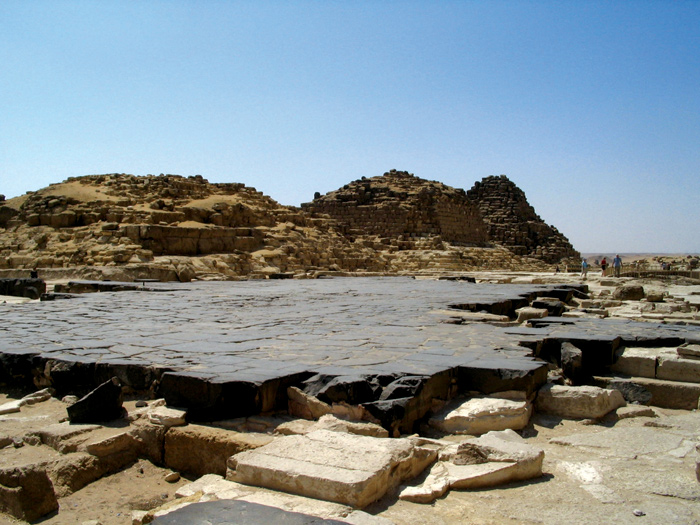

Possibly but there are problems with that in that they don't appear to drain anywhere or incline outwards and are set beneath the floors of the temples, for example this is the basalt flooring of the Khufu funerary temple which is of considerable thickness, i'm not sure if the conduit is seen there in the foreground but there is one set beneath.


What about passive solar energy heating system? If so than I suspect the capstone would offer such a clue. Even still there are various uses of
thermal heat and if granite was used as an insulator than consideration for radon poisoning was being devised. Maybe it was a built in vent for radon
gas? Or excess heat build up under the floors that would cause the foundation to crack or become compromised.
edit on 24-6-2015 by Rosinitiate
because: (no reason given)
If the interior stone blocks, those that fit into the grooved channels, were in contact with any interior stonework, then maybe they were used to show
any slippage from the interior stonework? You wouldn't want the exterior work to hide any interior damage, right?
Just an idea.
Excellent post as always, thanks.
Just an idea.
Excellent post as always, thanks.
a reply to: Rosinitiate
The ramps to build the pyramids were removed , covered over in some cases. Why not cover this grooved chunk of granite. The more I think about it, the more I tend to think thats what it was… functional. Easier to abandon in place than move away once the project was finished.
As far as hiding their prowess building stuff, they didn't leave many pictograms of their cranes did they, or writings about them?
I could be wrong on that account, but I haven't seen too many depictions they made of how they built the pyramids.
They are laughing right now… I hear them.
The ramps to build the pyramids were removed , covered over in some cases. Why not cover this grooved chunk of granite. The more I think about it, the more I tend to think thats what it was… functional. Easier to abandon in place than move away once the project was finished.
As far as hiding their prowess building stuff, they didn't leave many pictograms of their cranes did they, or writings about them?
I could be wrong on that account, but I haven't seen too many depictions they made of how they built the pyramids.
They are laughing right now… I hear them.
Were the temples perhaps the ancients slaughterhouses?
Any large congregation of peoples would need steady supplies of slaughtered meat. Maybe it was their way of getting all the blood to channel out of the preparing areas.
There is examples of literature where people bring sacrificial animals, and the priests get the choicest portions, perhaps because their function was also in food preparation.
Any large congregation of peoples would need steady supplies of slaughtered meat. Maybe it was their way of getting all the blood to channel out of the preparing areas.
There is examples of literature where people bring sacrificial animals, and the priests get the choicest portions, perhaps because their function was also in food preparation.
new topics
-
Cold Blooded Killers on Christmas!! GRRRRrrr!!
Pets: 4 hours ago -
Plane Crash Today --Azerbaijanian E190 passenger jet
Mainstream News: 8 hours ago
top topics
-
Orange County Makes Shoplifting a Felony
Other Current Events: 13 hours ago, 17 flags -
It's Offical Now
US Political Madness: 15 hours ago, 15 flags -
The reason it works is.....
General Chit Chat: 15 hours ago, 8 flags -
Cold Blooded Killers on Christmas!! GRRRRrrr!!
Pets: 4 hours ago, 7 flags -
Plane Crash Today --Azerbaijanian E190 passenger jet
Mainstream News: 8 hours ago, 6 flags
active topics
-
Statements of Intent from Incoming Trump Administration Members - 2025 to 2029.
2024 Elections • 54 • : WeMustCare -
DefCon Teetering on Escalation
World War Three • 51 • : WeMustCare -
-@TH3WH17ERABB17- -Q- ---TIME TO SHOW THE WORLD--- -Part- --44--
Dissecting Disinformation • 3813 • : WeMustCare -
1 Billion dollars
General Entertainment • 13 • : ColeYounger2 -
Cold Blooded Killers on Christmas!! GRRRRrrr!!
Pets • 6 • : rickymouse -
Plane Crash Today --Azerbaijanian E190 passenger jet
Mainstream News • 12 • : rickymouse -
It's Offical Now
US Political Madness • 15 • : Imhere -
Political Warfare & The Resister Special Forces Underground
Political Ideology • 2 • : NoCorruptionAllowed -
London Christmas Market BANS Word ‘Christmas’
Social Issues and Civil Unrest • 49 • : NorthOS -
Post A Funny (T&C Friendly) Pic Part IV: The LOL awakens!
General Chit Chat • 7956 • : KrustyKrab
